Protein A Resins Market Size
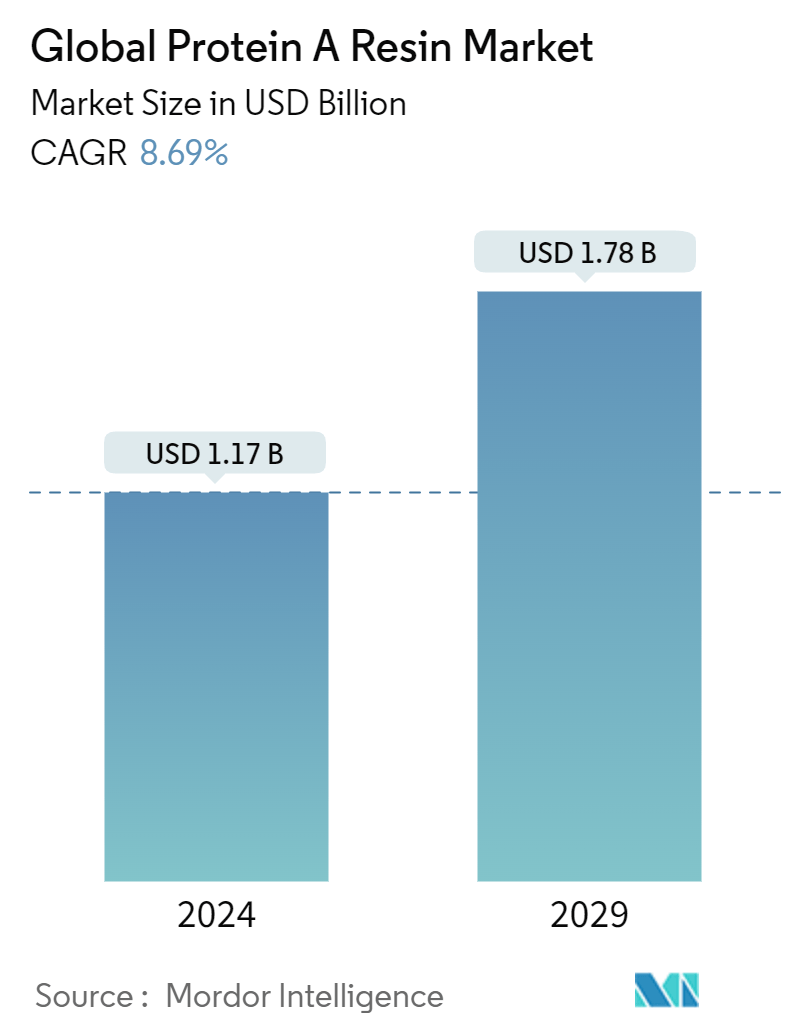
| Study Period | 2019 - 2029 |
| Market Size (2024) | USD 1.17 Billion |
| Market Size (2029) | USD 1.78 Billion |
| CAGR (2024 - 2029) | 8.69 % |
| Fastest Growing Market | Asia Pacific |
| Largest Market | North America |
Major Players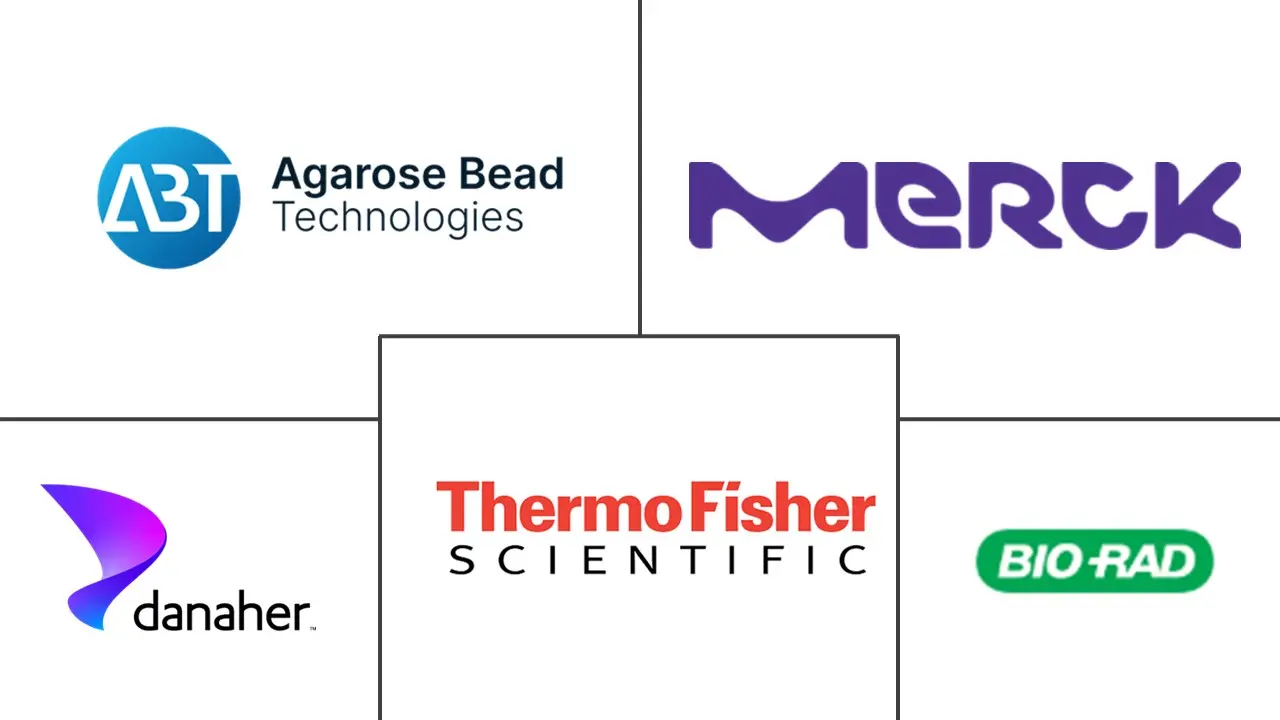
*Disclaimer: Major Players sorted in no particular order |
Need a report that reflects how COVID-19 has impacted this market and its growth?
Protein A Resins Market Analysis
The Global Protein A Resin Market size is estimated at USD 1.17 billion in 2024, and is expected to reach USD 1.78 billion by 2029, growing at a CAGR of 8.69% during the forecast period (2024-2029).
According to Cancer Facts and Figures 2023 by the American Cancer Society, the number of new cancer cases in the United States was estimated to be 1.95 million in 2023, of which 1.01 million were male and 0.94 million were female. Similarly, according to the February 2022 update by the World Health Organization, cancer prevalence was high, and it was evident in the most common types of cancer in terms of new cases. The rising burden of cancer is augmenting the demand for antibodies to manage disease complications, which is expected to drive the market’s growth over the forecast period.
The number of drug discoveries and research and development activities is increasing. Monoclonal antibodies are at the forefront of modern drug development, particularly in oncology, autoimmune diseases, and infectious diseases. Its targeted nature and high efficacy have led to a surge in the development of new mAb-based therapies. This necessitates a robust and scalable purification process, making protein A resin critical for biopharmaceutical companies. For instance, according to a report published by the Society of Biological Engineering Journal in February 2023, the increased demand for efficient purification methods in the biopharmaceutical industry, where increasing drug discoveries and R&D activities fuel the need for protein A chromatography, boosted the growth of the protein A resin market. The ability to reuse protein A resins across multiple products in GMP facilities can reduce costs and improve efficiency, further propelling market growth.
According to a report published by the Monoclonal Antibody Journal in January 2024, the growing focus on monoclonal antibody therapeutics, evidenced by an increase in drug discoveries and R&D activities, is driving the demand for protein A resin, a key component in antibody purification. As more antibodies are developed for clinical use and regulatory approval, such as lecanemab (Leqembi) for Alzheimer's disease and talquetamab (Talvey) for cancer, the need for effective purification processes using protein A resin is becoming more critical.
While several factors contribute to the growth of the market, the high costs associated with protein A resin are expected to impede the growth of the market over the forecast period.
Protein A Resins Market Trends
Pharmaceutical and Biopharmaceutical Companies are Expected to Dominate the End User Segment
Pharmaceutical and biopharmaceutical companies mainly use proteins as the principal target, and thus, protein analysis has a very important role in drug discovery and development in the pharma and biotech industries. The common application of protein analysis involves target identification, evaluation, identification of efficacy and toxicity biomarkers from readily accessible biological fluids, and investigations into mechanisms of drug action or toxicity. This, in turn, is expected to grow significantly due to a large number of ongoing drug development projects in pharmaceutical and biopharmaceutical projects across the world.
A rise in government funding for pharmaceutical research and development and technological advancements in the area of analytical instruments are expected to drive the growth of the segment. Also, increasing life science R&D expenditure, progressing drug discovery, and an increase in the adoption of chromatography are key factors driving the growth of the protein A resin market in the pharmaceutical and biopharmaceutical industries. For instance, in April 2024, Merck planned to invest around USD 324.67 million (EUR 300 million) for the development of a new, advanced research center in Darmstadt, Germany, dedicated to providing research solutions for manufacturing antibodies, mRNA applications, and additional products required for biotechnological production, among other things. In November 2022, Otsuka Pharmaceutical Co. Ltd (Otsuka) inaugurated the Osaka Research Center for drug discovery. It is a research facility focused on drug discovery in Minoh City, Osaka Prefecture, Japan. Thus, increasing investments in the development of research and manufacturing facilities focused on antibodies will generate the need for protein A resins, driving the growth of the market.
Increasing agreements for products and expansions to address the demand from the pharmaceutical and biopharmaceutical industries are also expected to contribute to the market's growth. For instance, in November 2023, Purolite, an Ecolab company, and Repiligen Corporation extended their agreement until 2032 to supply five high-performance ligands for bioprocessing. Furthermore, in January 2023, Ecolab Inc. started the expansion of the Purolite business with the addition of a new biologics resin manufacturing facility in Landenberg, Pennsylvania. With this, the company aims to strengthen the supply for global pharmaceutical and biotech customers by developing and producing lifesaving clinical and commercial-scale therapeutics for patients worldwide. Such initiatives demonstrate that pharmaceutical and biopharmaceutical companies generate a high demand for protein A resin, which is expected to boost the growth of the segment during the forecast period.
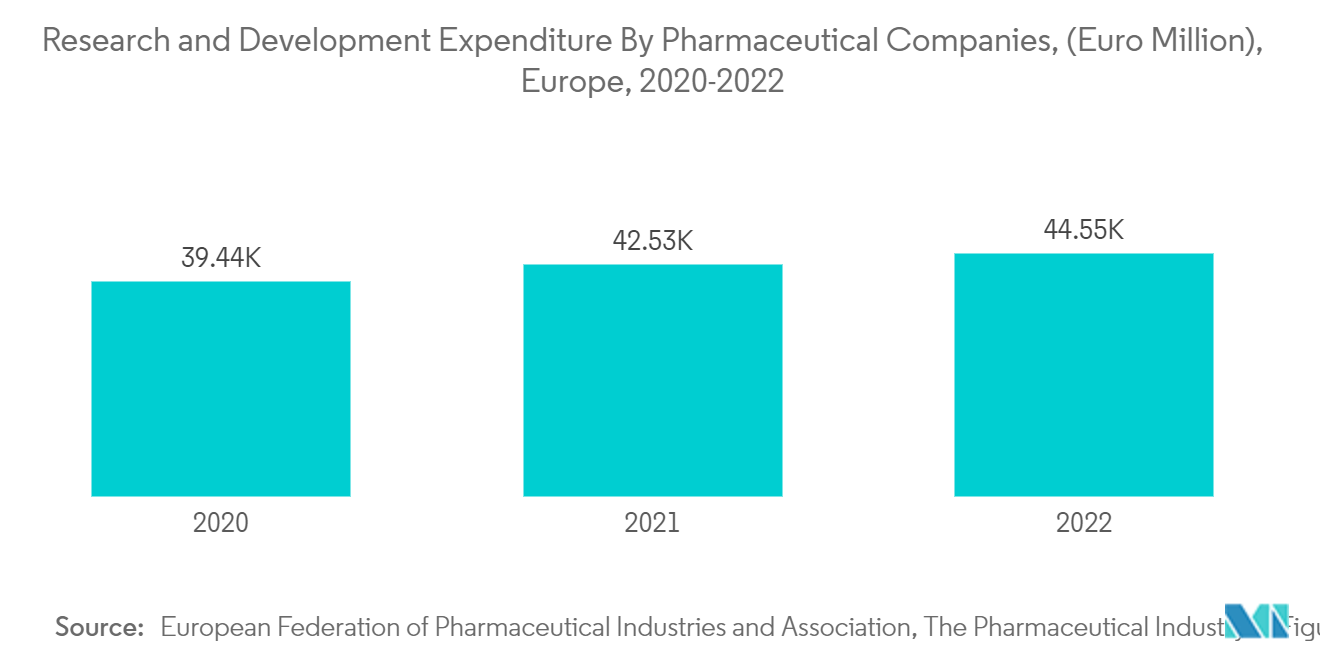
North America is Expected to Hold a Significant Share in the Market Over the Forecast Period
The market for protein A resin in North America is expected to experience lucrative growth owing to factors such as the rising burden of infectious and chronic diseases, technological advancements in the market, and increasing research and development expenditure on pharmaceutical and biological research. In addition, product launches and strategic initiatives by key market players contribute to market growth.
The biopharmaceutical industry in the United States is expanding rapidly, with an increasing focus on developing biologics such as monoclonal antibodies (mAbs) for therapeutic purposes. Protein A resins play a crucial role in the purification of these antibodies, driving the demand for such resins. For instance, according to ClinicalTrial.gov, as of March 2024, there were 1,248 clinical studies reported for monoclonal antibodies in the United States. Thus, a high number of clinical trials indicates a robust biopharmaceutical development pipeline, including monoclonal antibodies. Thus, the demand for protein A resins increases proportionally to support the purification and production processes at scale, boosting market growth.
The demand for antibodies that are used in chronic disease treatment is growing, and funding for it is expected to increase, leading to a rise in demand for protein A resins that are crucial for purifying and producing these antibodies at a large scale. In July 2023, the governments of Canada and British Columbia funded the construction of antibody-based facilities to bolster capabilities and infrastructure. The CAD 701 million (USD 515 million) investment aims to strengthen Canada’s capabilities and infrastructure for drug development, production, and clinical research. Additionally, in July 2023, Vancouver-based antibody manufacturer AbCellera was expected to invest CAD 401 million (USD 294 million) in antibody projects, and the governments of Canada and British Columbia contributed CAD 300 million (USD 221 million) collectively.
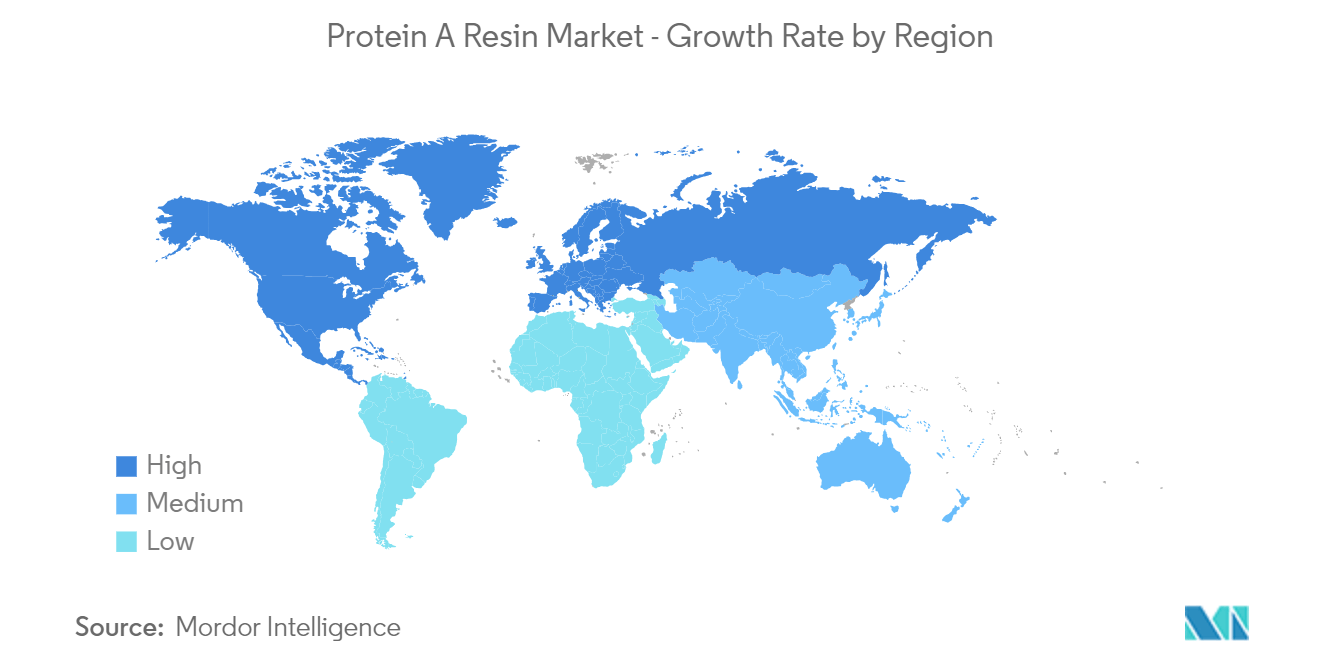
Protein A Resins Industry Overview
The protein A resin market is moderately competitive, with few players dominating it. Companies are taking the initiative to grow their presence in the market. Key players expected to dominate the market are Danaher Corporation, Thermofisher Scientific Inc., GE Healthcare, Merck KGaA, Agarose Beads Technologies, Bio-Rad Laboratories Inc., Expedeon Ltd, Genscript Corporation, Novasep, Purolite Lifescience, and Repligen.
Protein A Resins Market Leaders
-
Bio-Rad Laboratories, Inc.
-
Thermofisher Scientific, Inc.
-
Merck KGaA
-
Agarose Bead Technologies
-
Danaher Corporation (Cytiva)
*Disclaimer: Major Players sorted in no particular order
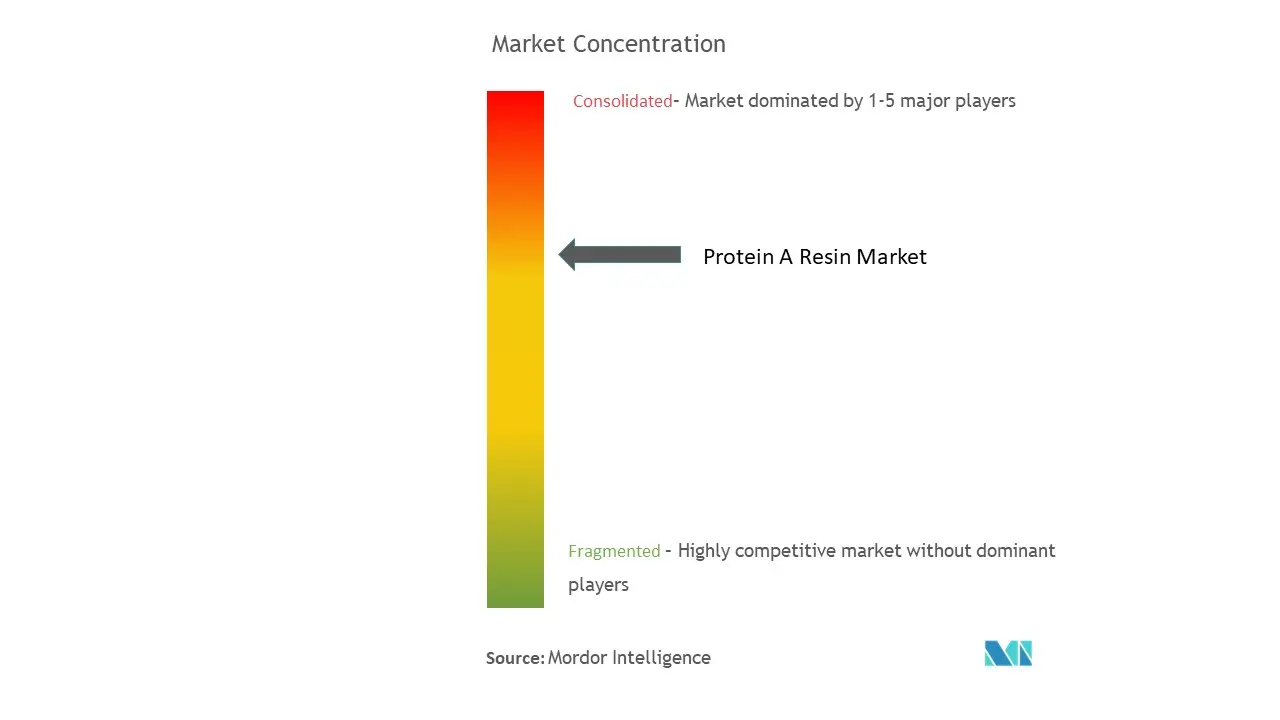
Protein A Resins Market News
- February 2024: Purolite, an Ecolab company, and Repligen Corporation reported the commercial launch of Praesto CH1, a new 70 μm (micron) agarose-based affinity resin designed to purify specialized mAbs such as bispecifics and recombinant antibody fragments.
- January 2024: Dutch Oxitope and Norwegian Arxx reported a merger to form Calluna Pharma Inc. to develop monoclonal antibody therapies for inflammatory and fibrotic diseases. The newly formed company raised USD 80.4 million (EUR 75 million) in Series A financing for the clinical stage lead program, CAL101, which is a monoclonal antibody that neutralizes the bioactivity of S100A4. CAL101 under Phase 1 for fibrosis and inflammation indications.
Protein A Resins Market Report - Table of Contents
1. INTRODUCTION
- 1.1 Study Assumptions and Market Definition
- 1.2 Scope of the Study
2. RESEARCH METHODOLOGY
3. EXECUTIVE SUMMARY
4. MARKET DYNAMICS
- 4.1 Market Overview
-
4.2 Market Drivers
- 4.2.1 Increasing Demand for Antibodies
- 4.2.2 Increasing Number of Drug Discoveries and R&D Activities
-
4.3 Market Restraints
- 4.3.1 High Cost Associated With Protein A Resin
-
4.4 Porter's Five Forces Analysis
- 4.4.1 Threat of New Entrants
- 4.4.2 Bargaining Power of Buyers/Consumers
- 4.4.3 Bargaining Power of Suppliers
- 4.4.4 Threat of Substitute Products
- 4.4.5 Intensity of Competitive Rivalry
5. MARKET SEGMENTATION (Market Size - Value in USD)
-
5.1 By Product
- 5.1.1 Agarose -based Protein
- 5.1.2 Glass or Silica-based Protein
- 5.1.3 Organic Polymer-based Protein
-
5.2 By Application
- 5.2.1 Antibody Purification
- 5.2.2 Immunoprecipitation
-
5.3 By End User
- 5.3.1 Pharmaceutical and Biopharmaceutical Companies
- 5.3.2 Research Laboratories
- 5.3.3 Other End Users
-
5.4 Geography
- 5.4.1 North America
- 5.4.1.1 United States
- 5.4.1.2 Canada
- 5.4.1.3 Mexico
- 5.4.2 Europe
- 5.4.2.1 Germany
- 5.4.2.2 United Kingdom
- 5.4.2.3 France
- 5.4.2.4 Italy
- 5.4.2.5 Spain
- 5.4.2.6 Rest of Europe
- 5.4.3 Asia-Pacific
- 5.4.3.1 China
- 5.4.3.2 Japan
- 5.4.3.3 India
- 5.4.3.4 Australia
- 5.4.3.5 South Korea
- 5.4.3.6 Rest of Asia-Pacific
- 5.4.4 Middle East and Africa
- 5.4.4.1 GCC
- 5.4.4.2 South Africa
- 5.4.4.3 Rest of Middle East and Africa
- 5.4.5 South America
- 5.4.5.1 Brazil
- 5.4.5.2 Argentina
- 5.4.5.3 Rest of South America
6. COMPETITIVE LANDSCAPE
-
6.1 Company Profiles
- 6.1.1 Agarose Beads Technologies
- 6.1.2 Bio-Rad Laboratories, Inc.
- 6.1.3 Abcam Limited
- 6.1.4 Danaher Corporation (Cytiva)
- 6.1.5 Genscript Corporation
- 6.1.6 Merck KGaA
- 6.1.7 Axplora
- 6.1.8 Ecolab Inc. (Purolite Lifesciences)
- 6.1.9 Repligen Corporation
- 6.1.10 Thermofisher Scientific Inc.
- 6.1.11 Tosoh Bioscience LLC
- 6.1.12 Kaneka Corporation
- 6.1.13 JSR Life Sciences
- *List Not Exhaustive
7. MARKET OPPORTUNITIES AND FUTURE TRENDS
** Subject To AvailablityProtein A Resins Industry Segmentation
As per the scope of the report, protein A resin is an affinity chromatography medium designed for easy, one-step purification of classes, subclasses, and fragments of immunoglobulins from biological fluids and cell culture media.
The Protein A Resin market is segmented by product type, application, end user, and geography. By product type, the market is segmented into agarose-based protein, glass or silica-based protein, and organic polymer-based protein. By application, the market is segmented into antibody purification and immunoprecipitation. By end user, the market is segmented into pharmaceutical and biopharmaceutical companies, research laboratories, and others. By geography, the market is segmented into North America, Europe, Asia-Pacific, the Middle East and Africa, and South America. The report also covers the estimated market sizes and trends for 17 countries across major regions globally. The report offers the values (USD) for all the above segments.
| By Product | Agarose -based Protein | |
| Glass or Silica-based Protein | ||
| Organic Polymer-based Protein | ||
| By Application | Antibody Purification | |
| Immunoprecipitation | ||
| By End User | Pharmaceutical and Biopharmaceutical Companies | |
| Research Laboratories | ||
| Other End Users | ||
| Geography | North America | United States |
| Canada | ||
| Mexico | ||
| Geography | Europe | Germany |
| United Kingdom | ||
| France | ||
| Italy | ||
| Spain | ||
| Rest of Europe | ||
| Geography | Asia-Pacific | China |
| Japan | ||
| India | ||
| Australia | ||
| South Korea | ||
| Rest of Asia-Pacific | ||
| Geography | Middle East and Africa | GCC |
| South Africa | ||
| Rest of Middle East and Africa | ||
| Geography | South America | Brazil |
| Argentina | ||
| Rest of South America |
Protein A Resins Market Research FAQs
How big is the Global Protein A Resin Market?
The Global Protein A Resin Market size is expected to reach USD 1.17 billion in 2024 and grow at a CAGR of 8.69% to reach USD 1.78 billion by 2029.
What is the current Global Protein A Resin Market size?
In 2024, the Global Protein A Resin Market size is expected to reach USD 1.17 billion.
Who are the key players in Global Protein A Resin Market?
Bio-Rad Laboratories, Inc., Thermofisher Scientific, Inc., Merck KGaA, Agarose Bead Technologies and Danaher Corporation (Cytiva) are the major companies operating in the Global Protein A Resin Market.
Which is the fastest growing region in Global Protein A Resin Market?
Asia Pacific is estimated to grow at the highest CAGR over the forecast period (2024-2029).
Which region has the biggest share in Global Protein A Resin Market?
In 2024, the North America accounts for the largest market share in Global Protein A Resin Market.
What years does this Global Protein A Resin Market cover, and what was the market size in 2023?
In 2023, the Global Protein A Resin Market size was estimated at USD 1.07 billion. The report covers the Global Protein A Resin Market historical market size for years: 2019, 2020, 2021, 2022 and 2023. The report also forecasts the Global Protein A Resin Market size for years: 2024, 2025, 2026, 2027, 2028 and 2029.
Malaysia Payments Industry Report
Statistics for the 2024 Malaysia Payments market share, size and revenue growth rate, created by Mordor Intelligence™ Industry Reports. Malaysia Payments analysis includes a market forecast outlook 2029 and historical overview. Get a sample of this industry analysis as a free report PDF download.

